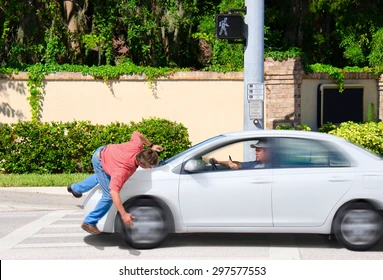
It was moderately amusing when Mordecai and Rigby tried to do infinite donuts against the Carter and Briggs posers. But there was nothing amusing about what happened to a New York man who was watching a car do donuts in Hudson Square.
Roughly 1,000 people were on hand to enjoy the stunt show in Soho. A few people moved closer to the spinning car to get better images on their cell phone cameras. One individual stumbled and fell. The driver, possibly unaware the man was there, ran over the 23-year-old man. Stunned witnesses looked on as the driver immediately took off.
Investigators have few leads and little hope of finding the negligent driver.
Financial Hit-and-Run Issues
Frequently, people don’t remain at accident scenes because they are afraid of the financial consequences. New York has one of the highest percentages of uninsured drivers in the nation. Additionally, the Empire State has one of the lowest auto insurance minimum requirements in the country.
So, there’s a good chance the tortfeasor (negligent driver) in the above story was either uninsured or underinsured. Moreover, there’s a good chance the insurance company would deny coverage. Most auto insurance policies deny coverage for accidents which occured while the driver was behaving like a jackass.
These financial issues make hit-and-run wrecks particularly complex. First, there’s the matter of tracking down the tortfeasor. Then, there’s the matter of how to handle the case, from a compensation standpoint. Most people are effectively judgment proof.
Police investigators often quickly give up on these matters. The burden of proof (beyond a reasonable doubt) is very high in criminal court. In most cases, there’s barely enough evidence to identify the driver, let alone prove the elements of a hit-and-run criminal case. Additionally, to many law enforcement investigators, hit-and-run is not a criminal matter. They reason that an insurance company, or perhaps a government program, will pay medical bills.
Fundamentally, police investigators care very little about victim compensation. They just want to get the bad guy.
A New York personal injury attorney has a much different perspective. Attorneys care deeply about victim compensation.
Additionally, the burden of proof (a preponderance of the evidence, or more likely than not) is much lower in civil court. A vague description of the vehicle and a partial plate number are usually sufficient to locate the vehicle’s owner. Since it’s more likely than not the owner was also the driver, the owner is legally responsible for damages, unless s/he has a rock solid alibi.
Multiple cell phone videos are available in the above story. One of these would-be Steven Spielbergs surely caught part of the tortfeasor’s license plate number. Therefore, tracking down the tortfeasor shouldn’t be a problem for an experienced attorney and a private investigator partner.
Since a guy doing donuts in a vacant intersection is most likely not independently wealthy, a lump sum non-insurance payment probably won’t happen. But accommodations are available. Typically, a New York personal injury attorney forces the tortfeasor to accept financial responsibility for the victim’s medical bills. Any payment arrangement is between the tortfeasor and the provider(s). As for noneconomic losses, attorneys often require tortfeasors to pay a small lump sum upfront and monthly payments on the rest. Most likely, those payments won’t arrive. But at least these victims get something.
Defenses in Pedestrian Accident Claims
Mostly because of medical bill inflation, damages in these claims are much higher than they were in the late 2000s, during the Great Recession. Additionally, these claims have increased 60 percent since the late 2000s. So, for insurance companies, there is a lot at stake. Additionally, insurance company lawyers are very experienced in these matters. Their case strategies usually revolve around one of the affirmative defenses listed below.
Emergency Doctrine
This defense is very common in pedestrian accident claims, especially non-crosswalk injuries. To set it up, insurance company lawyers usually claim the victim “darted out into traffic.” But words alone do not establish this defense. The insurance company must prove the tortfeasor:
These two elements are almost impossible to prove in hit-and-run pedestrian claims. Fleeing the scene of an accident is not a reasonable reaction. Furthermore, a jaywalking pedestrian, even one who “darts out into traffic,” is not a sudden emergency in this context. Instead, a jaywalking pedestrian is an everyday hazard, like a stalled car or a large pothole.
Comparative Fault
Since this defense is so hard to prove in pedestrian claims, insurance company lawyers usually don’t press the emergency doctrine too much. Comparative fault is different. This defense is much easier to prove, both legally and factually.
In this context, contributory negligence is basically a failure to mind your surroundings. Many pedestrian victims step into the street without stopping and looking both ways. If the pedestrian was using a device at the time, that’s even better, as far as the insurance company is concerned.
Legally, the victim’s inattention must have substantially contributed to the crash. One or two steps off the curb might not be a substantial contribution. Three or four steps is different.
Additionally, jurors must agree with the judge’s determination. In other words, once insurance company lawyers convince a judge that the defense applies, they must convince twelve jurors of the same thing.
Based on the evidence, jurors must divide responsibility between the victim and tortfeasor on a percentage basis. New York is a pure comparative fault state. Even if the tortfeasor is only 1 percent responsible for the wreck, the victim is entitled to a proportionate share of damages.
Injury victims are entitled to substantial compensation. For a free consultation with an experienced personal injury attorney in New York, contact the Pianko Law Group, PLLC. You have a limited amount of time to act.